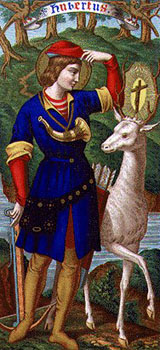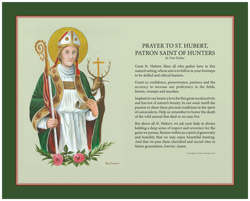The Blooding Rite - Why do we do it?
As I dabbed my index and forefinger in it and streaked it across my cheek I remember it feeling warm and having a distinct, but not unpleasant odor. Having always considered myself a do-it-yourselfer and not wanting to feel cheated out of anything associated with a first deer kill I couldn’t resist the temptation. I must admit, however, I had mixed feelings about standing over a dead deer in the middle of the woods with blood stains on my face with no witnesses. Neither did anyone hear my top-of-the lungs whooping. The more civilized part of me said this is really stupid. But the other side where the primal urge for the most part, lives deep in the brain recesses and usually dormant until times like this screamed out, “YES, THIS IS COOL!”
I had seen enough hunters, mostly kids, who after killing their first deer get smeared with blood from their prey to know the drill. Some went willingly; others had to be chased down, tackled and held still to receive their initiations. Apparently it’s not just a down south thing, as it goes on all across the country. Probably happens every day of the open deer seasons.
I often wondered why we do this to each other. Is it a rite of passage? There are lots of theories about the origin of the blooding ritual, all with slightly different takes. But for the most part all are centered on one event. And I believe that 99% of deer hunters who have had blood slopped on their face and have done a little smearing of their own have no clue as to why. I decided to find out and the results of my research were surprising.
First of all, its roots run deep – all the way back to the 1st century A.D. It also stems from a sacred, religious rite. That’s a far cry from the antics I’ve seen around hunting camps and skinning sheds. What goes on there is more like outtakes from Animal House. If you’ve been bloodied you can thank St. Hubert, that’s right the patron saint of hunters. His feast day is appropriately celebrated each November 3, usually not far from the beginning of the deer rut.
If you’ve been bloodied you can thank St. Hubert, that’s right the patron saint of hunters. His feast day is appropriately celebrated each November 3, usually not far from the beginning of the deer rut.
A legend, the degree to which it has been embellished will never be known, has nonetheless been passed down generation after generation for centuries. It is within this historical account whereby the origin of contemporary deer blooding rituals lies.
Hubert was born in 638 A.D. as a prince in the house of Aquitane in France. He was an ardent hunter but not what you might call a regular church-goer. His wife died giving birth to a son and Hubert gave up a position in the court and turned exclusively to pursue his passion – hunting. He moved into the Ardennes forest and did nothing but hunt. (I really like this guy.) On a Good Friday morning when villagers were crowded in the church, Hubert was on horseback. You see Hubert was a dog hunter, following his hounds in hot pursuit. Since there were no guns, he was also a bow hunter. A bow hunting dog hunter - by modern standards, this would be an interesting combination to say the least. Anyway the hounds had cornered a stag and as Hubert dismounted and readied his arrow, the animal turned and an illuminated crucifix appeared above the deer’s brow and in between its antlers. As Hubert must have been thinking if not saying, “What the __??” Then a voice spoke.
“Hubert, unless thou turnest to the Lord and leadest a holy life, thou shalt quickly go down into hell.” Hubert having seen and heard enough dismounted, hit the deck, and asked “Lord, what wouldst Thou have me do?” The voice answered, “Go and seek (Bishop) Lambert and he will instruct you.”
He took the hint, became a priest and eventually replaced Lambert as Bishop of Maastricht. Along the way, Hubert reportedly worked several miracles during his life including exorcising demons and curing a case of rabies after making the sign of the cross over the victim. Hubert was said to not only be immune to rabies, but also had the miraculous power to prevent widespread occurrences from happening to his fellow hunters’ packs at a time when there was no preventive inoculation. He also was responsible for literally bringing the hunt to the church. Owners and their hounds would attend special masses to “consecrate” the hunt. Unlike today when we hunters are better off operating below public radar behind locked gates, hunters at that time were referred to as heroes since a community’s sustenance often depended upon their skills.
As a tribute to St. Hubert a tradition began at the time of his death in 727A.D. When a hunter killed a deer a knife would be placed on the wound and covered with its blood. With the blade three crosses of blood were traced on the hunter, one on the forehead, and one on each cheek. This was to symbolize Hubert’s encounter with the deer with the crucifix in its antlers and for the hunter to acknowledge receiving the saint’s blessing for the kill. Other hunters in the group would stand and shake his hand in congratulations. Sure has been a lot lost from the sacred tradition just described to the blood slinging and guffawing that goes on at camps these days.
But there are still reminders of those more solemn occasions around and you can find them in practically every grocery store in the country. Where? Of all places to find it, it’s right there in the liquor department. The legend of Hubert and the cross-in the-deer-antler story is told on every bottle of Jaegermeister. Hubert’s religious representation is a stag bearing a cross or crucifix between its antlers. That same representation of the “Master Hunter” (Jaegermeister in German) Badge of Honor is displayed on the label of the herbal liqueur. Surrounding the label is a German phrase, which loosely translated means: This is the hunter’s badge of honor, which he protects and wears as his shield, to guard, while in the fine and honorable profession of hunting; which also honors the Creator and His creations.”
This spin off from medieval times provides both a link from hunting in Hubert’s day to more modern times in Europe and an explanation of how it has been absorbed into American hunting culture. German hunters also participate in rituals following the death of a big game animal that includes a toast to the fallen animal itself.
Besides a sloppy inconvenience, can bloodying a successful hunter be harmful? Yes and no, mostly no.
“A disease to be transmitted from a healthy deer to a human through blood to blood or blood to eye, mouth, mucous membrane or even an open wound would be extremely rare. In fact such a case has never been reported in Louisiana,” Scott Durham, LDWF Deer Study Leader said.
“However it’s theoretically possible that one of a few neurological viral diseases could be contracted if an infected deer’s blood came in contact through the methods mentioned. Those could be rabies, eastern equine infectious anemia or west Nile virus but there is no proof that anyone ever has. However, we strongly suggest that surgical gloves be worn when cleaning a deer or handling deer meat especially if that person has an open wound,” Durham said.  Although the blooding ritual is firmly entrenched in this country maybe we should reconsider a toast or some other act to fulfill our need to participate in celebrating a kill and honoring game. In the old days, Native American hunters repeated a prayer or chant or something as simple as a loud shout-out to express their joy of a kill. How about this for a grand celebration? We wear gloves when we butcher our deer, drink a toast of Jaegermeister to St. Hubert which won’t hurt our whooping and hollering a bit.
Although the blooding ritual is firmly entrenched in this country maybe we should reconsider a toast or some other act to fulfill our need to participate in celebrating a kill and honoring game. In the old days, Native American hunters repeated a prayer or chant or something as simple as a loud shout-out to express their joy of a kill. How about this for a grand celebration? We wear gloves when we butcher our deer, drink a toast of Jaegermeister to St. Hubert which won’t hurt our whooping and hollering a bit.
Don had commisioned a beautiful print of St Hubert accompanied by the hunters prayer that he is offering to his listeners and website visitors. It's called the ST HUBERT A PRAYER & PORTRAIT OF THE PATRON SAINT OF HUNTERS - it's a must have for every hunting camp. To view and obtain one of these prints, visit Don's Outdoor Mall.